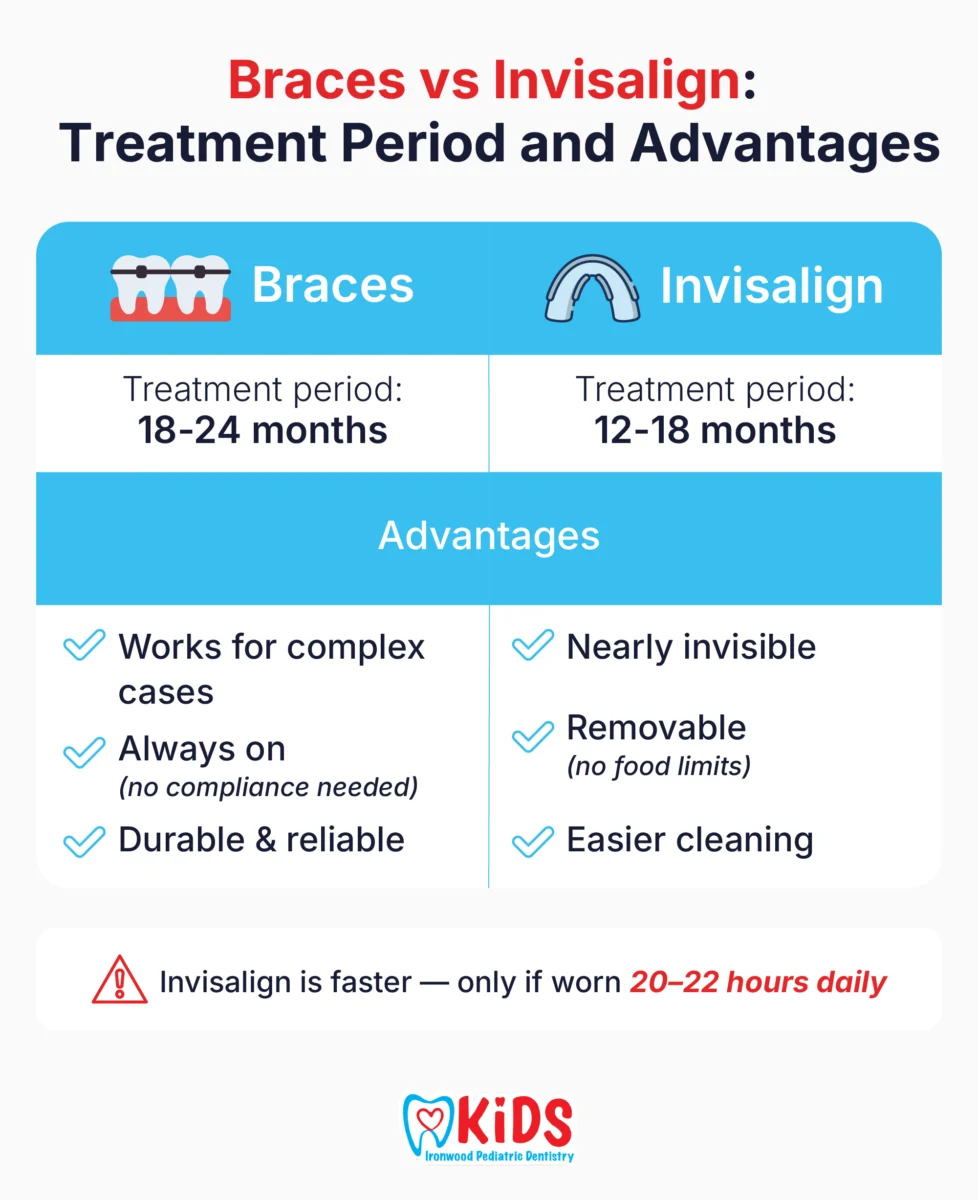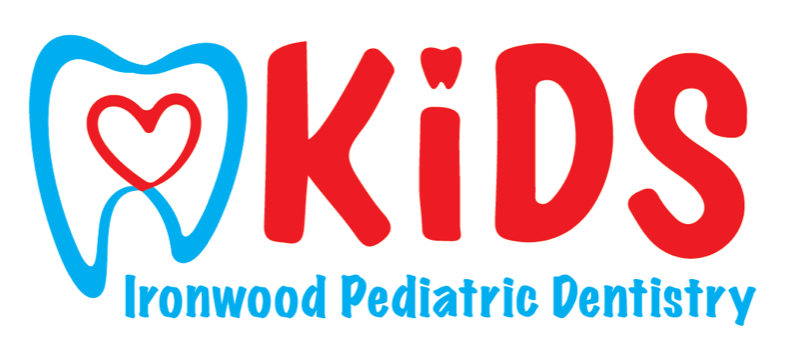The simple answer is that in mild-to-moderate orthodontic treatments, Invisalign may have a slight advantage compared to braces when it comes to the treatment time needed. This answer is subject, however, to several factors in the teeth straightening process that can affect the duration that orthodontics are needed.
In this post, we consider braces and Invisalign with a focus on how long each takes to complete, including influencing factors.
To learn more about whether braces or Invisalign is the best orthodontic treatment option for your child, call Ironwood Pediatric Dentistry at (480) 422-4544.
Timing Considerations for Invisalign Versus Braces

As a general rule, Invisalign treatment takes 12 to 18 months to complete as long as your child wears the aligner trays for the required number of hours each day. Compare this to the average treatment time of 18 to 24 months for braces, and the simple answer is that Invisalign is faster than braces.
However, this simple answer is subject to factors that can affect the actual time that your child’s course of treatment will take.
Most notably, if your child is using Invisalign but does not adhere to schedule, the Invisalign speed advantage can quickly be compromised.
In a case in which your child will need treatment for a complex dental problem, Invisalign may not be a practical option for you. In such a case, braces become the faster option by default.
What are the Differences Between Braces and Invisalign?
Traditional braces and Invisalign are effective in treating many kinds of orthodontic issues in children. Part of what affects their relative speed in treatment is based on the mechanics of how they work.
How Traditional Braces Work
Braces are teeth straightening orthodontic devices that use wires, brackets, and elastics. By making adjustments to the metal wires and elastics, your child’s orthodontist gradually moves the teeth into their desired alignment.
Traditional braces are effective in almost all orthodontic treatment cases, including complex malocclusions. However, they are not designed with speed of treatment in mind.
Are There Any Downsides to Traditional Braces?
The main drawback to traditional braces is their high visibility. This can be reduced by choosing an alternative form of braces, like ceramics that can be tooth-colored or lingual braces that place the arch wires in the inside or lingual tooth surfaces instead of the outer side.
How Invisalign Aligners Work
Unlike braces, which cannot be removed, Invisalign consists of custom-made aligners that fit onto the upper and lower teeth. These trays exert gentle pressure, straightening teeth in a way similar to how braces work. But instead of adjusting arch wires and elastics, your child will switch to a new set of trays about every two weeks.
Each new tray set is designed to build on the tooth realignment progress made from the set before. Computer technology plans out exactly how the teeth should reposition, so that your child’s results are precisely predictable.
Invisalign aligners offer several advantages to correct orthodontic problems compared to traditional braces:
- They are virtually invisible when worn.
- They are removable, so your child is not subject to the food restrictions that apply to braces like not eating hard, chewy, crunchy, or sticky foods.
- They make it easier to keep teeth clean by brushing and flossing.
- They are not subject to the possibility of broken wires or brackets.
- They can be more comfortable to wear.
Are There Any Downsides to Invisalign Treatment?
The main drawback to Invisalign treatment is that it requires considerable self-discipline to work effectively. Trays must be worn for 20 to 22 hours each day. If they are not, then the planned progress from one set of trays to the next can be slowed to the point where it is necessary to have new trays made. This can affect the speed of Invisalign treatment.
Another consideration when deciding between Invisalign and braces is that Invisalign treatment is best suited for mild to moderate cases, like spacing or minor tooth crowding problems. For more extensive treatment needs, traditional braces may still be the best choice.
Which is the Right Choice for Your Child’s Orthodontic Treatment?
Orthodontic treatment speed can be an important consideration when making an informed decision about whether to get braces or Invisalign. However, it is not the only consideration.
The real answer should include going over the following important factors:
- Does your child have the self-discipline to wear Invisalign for at least 20 hours per day?
- Does your child have the discipline needed to regularly clean Invisalign aligners to keep bacterial plaque from building up on them? If you are doubtful about this, then braces can be a lower-maintenance choice.
- Are comfort issues at play? Does your child have sensitive teeth and gums? In this case, Invisalign may result in less mouth discomfort than braces.
- If you are paying out of pocket, how much can you afford to pay for orthodontic treatment? On average, Invisalign costs between $3,000 and $7,000, while braces cost a little less at between $2,000 to $6,000. For some parents, this can be a deciding factor.
- If your child has a strong preference for a low-visibility orthodontic option, then the virtually invisible nature of clear aligners has an advantage over braces. Likewise, Invisalign treatment is subject to fewer dietary restrictions on what your child can eat.
- If you are concerned with possible problems your child may have maintaining good oral health with braces, then removable Invisalign trays have an advantage over braces.
Comparing Invisalign to Braces
When it comes to wearing Invisalign clear aligners versus braces, you have many things to think about. We have put together a table below to give you a clear sense of what the differences are between Invisalign and traditional braces.
The following table from our Invisalign web page provides a summary of the factors to weigh when choosing between Invisalign and braces:
| Factor | Metal Braces | Invisalign Aligners |
| Material | Stainless steel. | Patented SmartTrack plastic. |
| Visibility | High: braces do not match tooth color at all. | Low: Clear plastic trays with no arch wires. |
| Durability | High for brackets; arch wires are also strong, but more likely to break than brackets and to require emergency orthodontist attention to fix. | High: Durable SmartTrack plastic is not subject to breakage. Invisalign aligners are also meant for limited-duration use, usually not more than two weeks per aligner. |
| Allergenic Properties | Medium: Nickel used in metal braces can cause contact dermatitis allergic reactions in some cases. | Low |
| Orthodontic Uses | Multiple: Used for many complex dental treatments. | Can be used for many orthodontic purposes. Mostly used for tooth spacing problems. |
| Susceptibility to Staining | Low risk. | Low risk: Invisalign aligners are meant to be removed before eating or drinking, but can be stained by colored beverages if left in while drinking. |
| Tooth Enamel Demineralization Risk | Low risk. | Low risk as long as teeth are clean before inserting the Invisalign aligner. |
| Ease of Removal | Cannot be removed by the patient.Moderate difficulty in orthodontist removing cemented-in brackets. | Easy to remove and replace. Invisalign aligners are purpose-made to be removed and reinserted by the wearer with no assistance. |
| Hygiene and Ease of Cleaning | Moderate. Food particles can become trapped in the braces, and plaque buildup can occur around the brackets. Flossing can be difficult and incomplete because of interference from brackets and arch wires. | Very easy to brush and floss teeth when the Invisalign aligner is removed. The wearer can also clean the aligner before placing it back in the mouth.Wearers should brush teeth after eating before re-inserting aligners to avoid risk of tooth staining and tooth decay. |
| Risk of Injury | Low, but arch wire breakage can lead to mouth injury from cuts and sores caused by broken wire ends, including possible infection of wounds. | None. No arch wires or brackets that can break. |
| Cost | Costs usually a few thousand dollars. | Comparable to stainless steel or ceramic braces. |
| Food restrictions | Some foods that are hard, crunchy, sticky, or chewy can lead to brackets losing adhesion to teeth or to arch wire breakage.Examples: corn on the cob, taffy, gum. | No food restrictions when the Invisalign aligner is removed while eating or drinking. |
| Time needed to produce results | One to three years, depending on factors like the complexity of the orthodontic treatment needed. | Invisalign aligners can deliver results in a year or less, but 12 to 18 months is common. |
Do You Have Questions About Invisalign Versus Braces Treatment?
At Ironwood Pediatric Dentistry, we provide a full range of treatment options for child orthodontic problems. We use traditional braces, ceramics, and lingual braces. We are also certified Invisalign doctors, who offer the full range of Invisalign products. We offer free Invisalign consultations so you can find out how—and how soon—Invisalign can work for you.
To speak with an experienced pediatric dentist or orthodontist about your child’s orthodontic issues and how to achieve a beautiful smile, call us at (480) 422-4544. Or, use our online contact form to ask us a question or schedule an appointment for your child.
